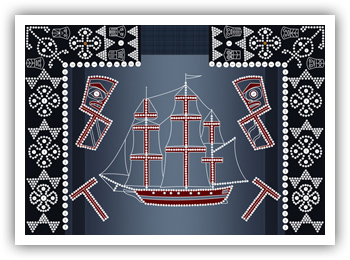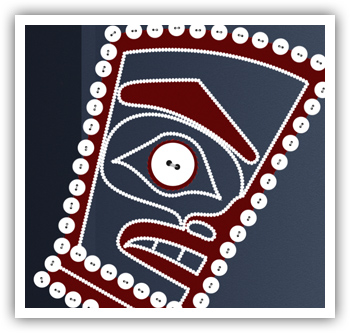| 
(Click Image to Enlarge)

(Print Detail) |
Oceans of Wealth
Giclée
Edition 25
Released June 2011
Primary: Available
A/P: SOLD OUT
You can often see these robes in movement in our Big Houses. They are garments meant to be worn and meant to be used. Covered with appliqué, buttons and beads to show the crests of the wearer, they are meant to tell a story and are meant to tell where a person is from. As the dancers move, they flow like waves upon an ocean of wealth.
My ancestry is mixed and I make no effort to neither hide nor deny it--it is part of who I am. My genetic makeup largely comes from England, from Norway, from the Pentlatch and from the Kwaguł and the ‘Na̱mg̱is of the Kwakwaka’wakw. Some of my ancestors fought in the War of the Roses, the War of Independence and the American Civil War. Some were literally Kings and Queens of England, while many many more were peasants trying to find a way to survive. Many were nobility amongst our people here and some were even slaves. I have a very rich history and as I think back in time, my mind becomes lost in these oceans of wealth.
When the first Europeans set foot on these territories, they were confronted with a rich and complex economic system centered on the potlatch. Interest-bearing loans were a regular and frequent activity amongst my ancestors. Shield-like items--called “t̕łaḵwa”--made from native copper were used to build up wealth. The “copper” was composed of three main parts: the “u’gwa̱mi” (upper part or face), the ”ga’lasi” (crosspiece, backbone or T) and the “uxsti” (lower sides or ribs). When a chief wished to insult his rivals, he would break a corner off his copper and present the broken segment to his enemy. The onus would be on the rival to return a piece of equal or greater value in order to save face. Coppers used in many quarrels would only have the T-shaped backbone remaining to represent its role in the oceans of wealth.
The copper-clad hulls of the large European vessels looked quite attractive to the people of the Northwest Coast. Large sheets could be easily attained through trade--eventually replacing native copper in the making of t̕łaḵwa. People from Spain, England, and “Boston” descended on this area with greater frequency in the pursuit of wealth. Looking for sea otter furs for the lucrative Chinese market, they were more than happy to trade just about anything to get it: woolen blankets, buttons, firearms and metals. As our people became more and more wealthy, potlatching became even more frequent and elaborate. Rivalries were created and coppers were broken--it was a heated and tumultuous time as my ancestors rode on these oceans of wealth.
In this piece, I pay tribute to the elaborate button blankets of my ancestors: the borders are very similar to my grandmother’s favourite “ḵ̓a̱ngex̱tola“ and the coppers in the central field pay homage to another that was in her box of treasures. Both are now in museums. It is no coincidence that the coppers get more and more broken as they get closer to the ship--there will always be waves when two opposing economies converge upon oceans of wealth.
“Oceans of Wealth” is a limited edition print using the giclée method of printmaking. This print was released in June of 2011 and printed by Andy Everson at Copper Canoe, the artist’s own studio in Comox B.C. A total of 28 prints bear the title “Oceans of Wealth” and are signed by Andy Everson: 25 in the primary edition bearing the numbers 1/25 through 25/25; 2 Artist’s Proof; and 1 Printer’s Proof. The acid-free Moab Entrada 100% cotton rag paper measures 17x22 inches. Image size measures about 14x20 inches.
|